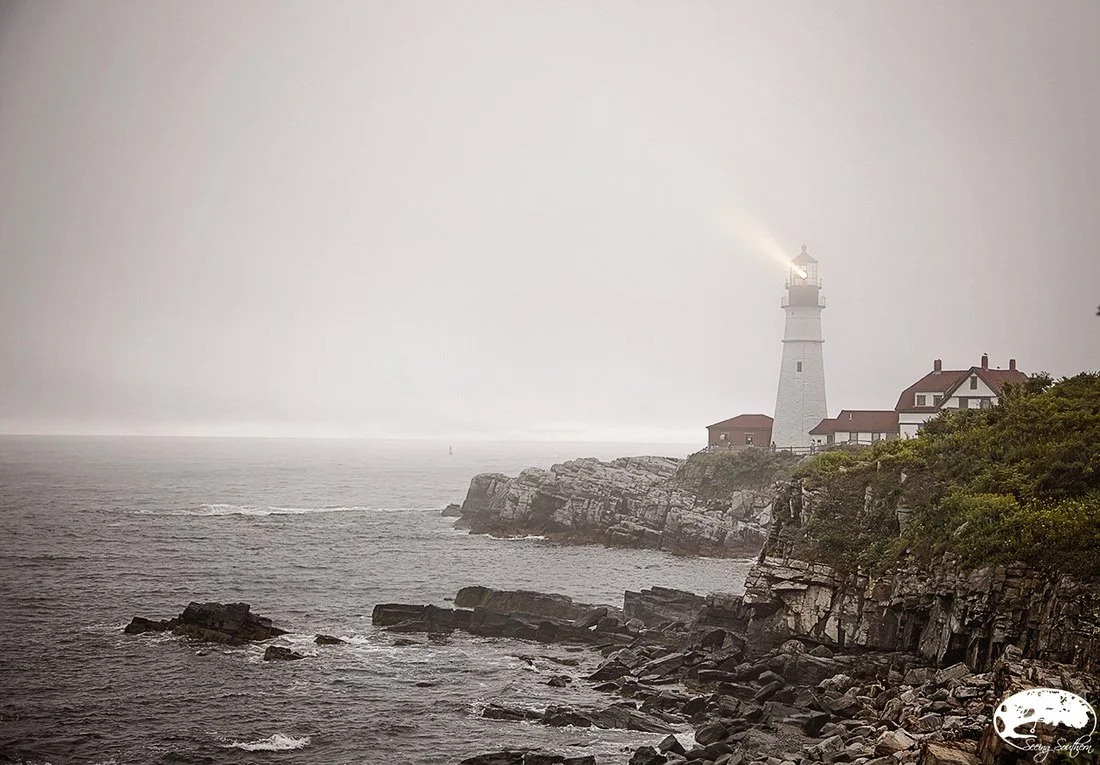The Soul of Maine’s Coastline
Each step of a lighthouse keeper told a story. From land to light and back again. His symbol, the lighthouse, told one, too. Along the 5,000 miles of jagged Maine coastline and its nearby islands are 65 historical lighthouses whose stories have weathered the test of time and remain standing today.
It was obvious during our trip to Maine that we weren't the only people drawn by the lure of the lighthouse. From the south to the north along the coastline, we paused with many of the same travelers, walking around, observing and taking note of its history and beauty. For as many that were accessible by land, there were many whose only access or view was by sea. Through sunshine and extreme fog, we photographed these beacons that once played an important role in the everyday life of mariners; many light stations are still operational while some have not weathered time or necessity as well.
Possibly a lesson for the ages, a light head's existence has remained a majestic symbol even through isolation and automation. Keepers and caretakers have disappeared; the Coast Guard no longer requires their service for many reasons, some understandable. Now, it is the community who must come to the rescue. Look below at the Rockland Breakwater Lighthouse. When it became fully automated in the 1960s, a discussion followed about tearing down the structure and replacing it with a lightpole. A lightpole. In Mackinaw Island, Michigan, the St. Helena Island Lighthouse was abandoned in 1920 and remained that way until a restoration project began in 1986 by the Boy Scouts of Ann Arbor. There's even a doomsday list of the most endangered lighthouses. And to this list of names, you must add the millions of dollars needed for restoration. Not a light task for one who is simply drawn to history.
The one most northern is found across the border in New Brunswick. We made our way to the path that led to the East Quoddy Light (Head Harbour, 1829). Rain and fog poured in. Inside a shack at the top of the hill sat a volunteer, eager to share the story of East Quoddy. She told us about how it was low tide now, so we could make our way to the small group of islands which we couldn't see. We even had to take her word that a lighthouse stood in the distance; we couldn't see 20 feet in front of our feet. Then, the fog horn sounded. "The water rises five feet an hour" once the tide changes and begins to rise, and if you don't pay attention, you'll be stuck and have to wait the entire day. It was the town and the Friends of the Head Harbour Lightstation organization who took back East Quoddy from decline, raising money for restoration (thus the $5 charge to visit the islands, $10 to see the keeper's house - 1840) and hoping that one day visitors can stay the night in the keeper's house. When they began restoration, explains one of the volunteers as he shares a scrapbook of photos, it was boarded up. Membership for Friends is a mere $35. They accept donations and welcome visitors daily, even during the fog. Like the lighthouse with the signature St. George cross daymark, they are in it for the long haul. For nearly 200 years, it had guided ships entering the Passamaquoddy Bay, navigating through dense fogs, high tides, treacherous rocks, rocky cliffs and shoals.
The National Historic Lighthouse Preservation Act of 2000 provides for the disposal of Federally-owned historic light stations by transferring them at no cost to Federal agencies, state and local governments, nonprofits, educational agencies or community development organizations. These must be financially able to maintain the historic light station and then make it available for education, park, recreation, cultural or historic preservation purposes to the general public at reasonable times and under reasonable conditions. Only those determined eligible for listing can be disposed. Light stations not eligible for listing will be disposed of through other processes (auction or donation). The National Park Service provides lists of lighthouses that are available. All properties are offered "As Is" and "Where Is" and must be maintained in accordance with the Secretary of Interior's Standards for Rehabilitation. Most are on the National Register of Historic Places.
BASS HARBOR (above): Built in 1855, this 56-foot lighthouse sits at the mouth of Bass Harbor and located in Acadia National Park. It is a private Coast Guard residence, but you can get close to the part of the grounds. It is active to navigation. BEAR ISLAND (above right): Located in the community of Cranberry Isles, the 31-foot light station was built of brick in 1889. It is visible from the water and is closed to the public.
Resources
Maine Lighthouses: Illustrated Map & Guide. Robert Hartnett. Excellent addition to travel books. Fold-out map with history as well as directions and suggestions.
Explorer's Guide Maine Coast & Islands: Key to a Great Destination. Nancy English. Excellent resource with out-of-the-way adventures and up-to-date observations.
American Lighthouse Foundation
National Park Service











